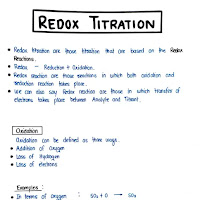Unit-4 Pharmaceutical Analysis Handwritten Notes: Redox Titrations
Download these handwritten notes covering Unit-4 of Pharmaceutical Analysis, focusing on Redox Titrations. These notes provide a simplified overview of the concepts, principles, and applications of various redox titrations.
Keywords: Pharmaceutical Analysis, Unit-4, Handwritten Notes, Redox Titration, Oxidation, Reduction, Cerimetry, Iodimetry, Iodometry, Bromatometry, Dichrometry, Potassium Iodate, PDF Download, Study Material.
Exploring Redox Titrations: Unit-4 Pharmaceutical Analysis Handwritten Notes Explained
Unit-4 of Pharmaceutical Analysis focuses on Redox Titrations, a crucial category of analytical techniques used to quantify substances through oxidation-reduction reactions. These handwritten notes aim to provide a clear and accessible understanding of the core concepts and applications of these titrations.
(a) Concepts of Oxidation and Reduction:
Redox titrations are founded on the transfer of electrons between chemical species. The notes are expected to explain:
- Oxidation: The process where a substance loses electrons.
- Reduction: The process where a substance gains electrons.
- Oxidizing Agent: The substance that accepts electrons and, in doing so, gets reduced.
- Reducing Agent: The substance that donates electrons and, in doing so, gets oxidized.
- Balancing Redox Equations: Essential principles and methods for accurately balancing chemical equations that involve oxidation and reduction processes.
(b) Types of Redox Titrations (Principles and Applications):
The notes likely cover the principles and applications of several prominent redox titration methods:
- Cerimetry: Titrations that utilize ceric ammonium sulfate (Ce4+) as the oxidizing agent. This technique is valuable for determining the concentration of substances like ferrous salts, oxalates, and hydrogen peroxide.
- Iodimetry: Direct titrations employing iodine (I2) as the oxidizing agent. It is commonly used to quantify reducing agents like ascorbic acid (vitamin C) and thiosulfate.
- Iodometry: Indirect titrations where iodine is liberated through the reaction of an oxidizing agent with iodide ions (I-). The liberated iodine is subsequently titrated with a standardized solution of sodium thiosulfate. This method is suitable for determining oxidizing agents like copper(II) ions and hypochlorite.
- Bromatometry: Titrations using potassium bromate (KBrO3) as the oxidizing agent. It is applied in the determination of organic compounds containing double bonds and aromatic amines.
- Dichrometry: Titrations that utilize potassium dichromate (K2Cr2O7) as the oxidizing agent. This method is used to determine ferrous ions and various organic compounds.
- Titration with Potassium Iodate: Titrations employing potassium iodate (KIO3) as the oxidizing agent. This method is used in the determination of ascorbic acid and other reducing agents.
Key Concepts Covered for Each Titration Type (Likely):
It's anticipated that for each titration type, the notes would cover:
- The Oxidizing/Reducing Agent: The precise chemical compound used in the titration process.
- The Indicator (If Any): The specific indicator employed to visually detect the endpoint of the titration.
- The Balanced Reaction Equation: The correctly balanced chemical equation representing the redox reaction.
- Typical Applications: Real-world examples of substances that can be effectively quantified using the specified titration method.
Benefits of Using Handwritten Notes:
These handwritten notes are designed to be a beneficial resource for students and professionals looking for a simplified and accessible overview of redox titrations in pharmaceutical analysis. Their goal is to complement standard textbook materials and act as a useful aid for exam preparation and quick review sessions.
Download these Unit-4 Pharmaceutical Analysis handwritten notes to improve your comprehension of redox titrations and their various applications within the field of pharmaceutical analysis.
Info!
If you are the copyright owner of this document and want to report it, please visit the copyright infringement notice page to submit a report.

